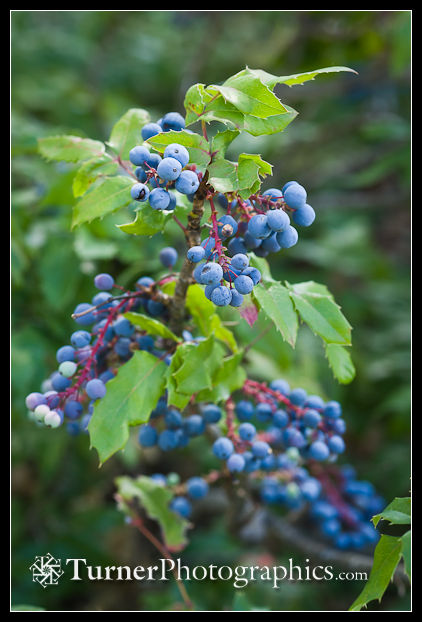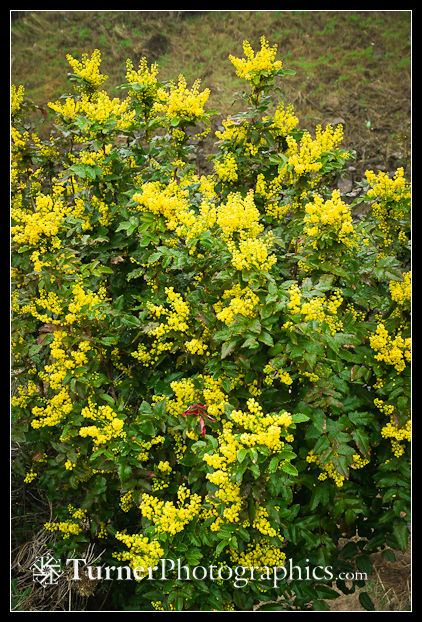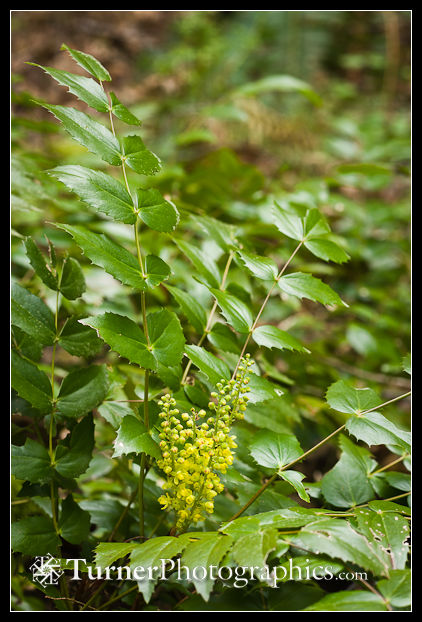Plant of the Month: Oregon-grape
Oregon-grapes are among our wonderful broadleaf evergreen shrubs here in the Pacific Northwest. There are several species but the two most common natives are Berberis aquifolium, tall (or shining) Oregon-grape, and Berberis nervosa, low (or dull) Oregon-grape. There are also numerous horticultural cultivars, some of which will begin blooming in late December.

Oregon-grapes get their name from their small deep blue berries, ripening in late summer, that resemble clusters of grapes. The fruit is edible, but a bit tart, and is said to make good jam or jelly although I’ve never cooked up any myself. We hyphenate the common name because the hyphen indicates that the plant is not a true grape, just one that looks a bit like one. The plants have also been moved back and forth between Mahonia and Berberis in recent years. Flora of North America puts them all in Berberis. Horticultural references may still list them as Mahonia.
Oregon-grape comes to mind this time of year because it is a good native alternative to English Holly, which can invade our woodlands as birds spread seeds. While Oregon-grape doesn’t have the bright red berries of the holly, it has similar foliage and is an excellent wildlife shrub. You can decorate for the holidays with Oregon-grape foliage the same way you would with English holly boughs.
 Berberis aquifolium, shown at the left, is native throughout the west coast states and British Columbia as well as being found sporadically in the East.
Berberis aquifolium, shown at the left, is native throughout the west coast states and British Columbia as well as being found sporadically in the East.
Berberis nervosa, shown at the bottom of the post, is only found from BC down to California.
Oregon-grape is easy to grow in a wide variety of conditions. It’s shade-tolerant but also thrives in full sun. It prefers acidic soil, but accepts some alkaline environments as long as the pH is below 8.
Individual stems may live up to 10 years, but clonal colonies thrive much longer than that. It accepts pruning so in a garden environment you can keep it trimmed to a manageable size. We have one in our back garden in the partial shade of the street trees that we keep pruned to about the height of the fence behind it. It looks best when individual stems are removed when they get too tall, allowing younger ones to grow up and take their place. We get some winter burn on the foliage but by mid-summer new foliage has the shrub looking great again.
Propagate Oregon-grape either by purchasing nursery stock, collecting seeds, or by rooting cuttings. Since it spreads by suckering you can also transplant offshoots. This works best if you sever the offshoot from the mother plant and then wait several months before digging. This allows the offshoot to form a stronger root system on its own. Digging up seedlings in your garden also works. Remember that digging wild plants is not a good practice and is often unsuccessful.
 More information about Oregon-grape is available in a Forest Service publication or in Gardening with Native Plants of the Pacific Northwest: Second Edition, Revised and Enlarged
More information about Oregon-grape is available in a Forest Service publication or in Gardening with Native Plants of the Pacific Northwest: Second Edition, Revised and Enlarged
For additional photos of our native species of Oregon-grape, visit my Pacific Northwest Wildflowers website.

